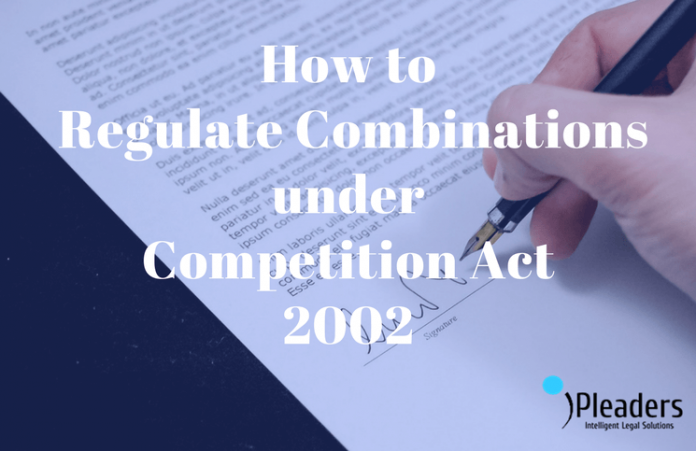This Article “How To Regulate Combinations Under Competition Act 2002” is written by Ishita Mehta.
This work seeks to analyze the law relating to regulation of combinations, as laid down by the Competition Act 2002 and to develop a model for merger control guidelines.
Need Of A New Legal System
After independence the most significant decision that altered the lives of Indians entirely was the decision to liberalize the economy.
India’s decision in 1991 to liberalize its economy implied a change in the market structure, which had to be induced by a change in the legal structure.
A liberalized economy meant we had to make the market structure compatible with the western capitalist model. The License Raj had to be replaced and the market had to be induced to accept the capitalist values of competition, efficiency, consumer supremacy and pursuit of self-interest.
These changes, like any other, necessitated the existence of a legal system that sustained them.
Enactment Of Competition Act 2002
A necessary ingredient of any liberalized economy has been the encouragement of fair competition. The entire concept of laissez faire is in fact based on the concept of fair competition and a dynamic economy.
Acceptance of a new system of economy required a new system of laws.
One of the consequences of the need to change the legal system was the enactment of the Competition Act, 2002.
Since 1969, the legal theory that governed the Indian legal regime in the area of competition was regulating corporate enterprises to prevent the concentration of economic power to common detriment, control of monopolies, prohibition of monopolistic and restrictive trade practices. However, it was realized that the legal theory needs to be altered which required a change in the legal system as well.
The objectives had to be altered to provide, keeping in view the economic development of the country, the guiding principle shifted to preventing practices having adverse effect on competition, promoting and sustaining competition in markets, to protecting the interests of consumers and ensuring freedom of trade carried on by other participants in markets, in India.
After a long wait in 2002, India changed the approach of its legal system from prevention of monopolies to the encouragement of competition.
Most provisions of the Competition Act 2002, or the Act, as amended by the Competition (Amendment) Act 2007, were brought into effect on May 20, 2009.
The Act, hence, seeks to regulate an activity which has been on an increase in all corporate houses- combinations- commonly referred as to mergers and amalgamations. However, while the provisions of the Competition Act 2002 regulating anti-competitive agreements and abuse of dominance have been made effective, those regulating mergers and acquisitions or “combinations” have not.
A Need To Regulate Combinations…
The Competition Act 2002 much like its counterparts in other countries controls anti-competitive agreements, abuse of dominance and regulates combinations. This nascent Act is bound to have a lot of impact in the Indian market.
However, the provisions of the Act are also a consequence of the massive changes the Indian market is undergoing.
The last 2 years have witnessed significant cross-border mergers and acquisitions activity by Indian companies in India on a scale that is unprecedented.
Indian corporate houses have faced great competitive pressures but have surmounted various impediments and obstacles to acquire global presence and strength to challenge foreign MNCs in their “home” markets.
Liberalization has led to the addition to a new key feature, which is the swift growth of transactional mergers to meet the growing demands of the economy.
The Competition Act 2002 hence seeks to regulate an activity which has been on an increase in all corporate houses- combinations- commonly referred as to mergers and amalgamations.
However, while the provisions of the Competition Act 2002 regulating anti-competitive agreements and abuse of dominance have been made effective, those regulating mergers and acquisitions or “combinations” have not.
Law On Regulation Of Combinations- A Detailed Analysis
The provisions relating to regulation of combinations are given in sections-5, 6 and 20 of the Competition Act 2002.
As per the Competition Act 2002, regulation of combinations will be done ex-ante, although the Commission has the power to investigate a combination even after it has taken effect.
Combinations which cause or are likely to cause appreciable adverse effect on competition have to be prevented.
The regulation of combinations will have far reaching effects on the Indian market. With the establishment of another regulatory agency for controlling mergers and acquisitions the impact on the market is bound to be significant.
Since the law on regulation of combinations is new, a study analyzing the impact of the statutory framework is needed, especially due to the limitations of literature on the subject.
My study seeks to provide a direction for the development of law on regulation of combination in India- in light of the national and the international scenario.
Since the decisions are still to be rendered, it is the appropriate time to analyse the law on regulation of combinations, so as to provide a direction of development for the law. This study seeks to provide that direction.
It is noteworthy that the Competition Commission Of India(CCI) in 2008 came out with the proposed draft of the Competition Commission of India (Combination) Regulation.
The regulation faced stiff opposition from the key players, due to which, the draft was not implemented.
This work also seeks to provide an understanding of how the regulations should be framed so as to satisfy the concerns of the interest groups and be consistent with the international standards.
The basic tenets of democracy and market competition are ingrained in the same value system, i.e. freedom of individual choice, abhorrence of concentration of power, decentralized decision making and adherence to the rule of law.
The common goal of both democracy and market competition is the same- to ensure public welfare.
Anyhow, firms while competing with one another often adopt unfair means to restrict competition. This relates to fixing prices with rivals, setting price which is lower than cost in order to throw out competitors from the market, taking advantage of a monopoly position and charging unreasonable price, and the like.
This is where competition law 2002 assumes a pivotal role in achieving the targets of democracy and economic justice.
Suggestive Read: Competition Law in India
What is Combination?
A combination includes-
- The acquisition of control, shares, voting rights or assets of one or more enterprises by one or more persons.
- Control by a person over an enterprise when such person has already direct or indirect control over another enterprise, that is engaged in the production, distribution or trading of similar, identical or substitutable goods or service.
- The merger & amalgamation of the enterprises.
Mergers and amalgamations are a part of combinations and so are the Joint Ventures.
However, analysis of the meaning of combination is incomplete without making an analysis of the thresholds limits.
As stated, any combination will come within the ambit of the Competition Act only when it crosses the threshold limits prescribed under the Act.
Most mergers do not harm competition. Many mergers enable the merged firm to reduce costs and become more efficient, leading to lower prices, higher quality products or increased investments in innovation.
Some mergers, however, may harm competition by creating or enhancing the merged firm’s ability or incentives to exercise market power either unilaterally or through coordination with rivals.
This’d result in-
- Price increase above competitive levels for a significant period of time.
- Reduction in quality of the product.
- Reduction in the rate of innovation.
Merger review laws and policies should provide competition agencies with the ability to differentiate mergers that are unlikely to have significant anti-competitive effects from those that require more analysis.
The identification of those mergers that potentially threaten to harm competition and expeditious clearance of non-problematic mergers can lead to more efficient use of agency resources and more effective analysis of critical legal and economic issues.
During the 1990s, several developing countries updated or enacted antitrust laws as a part of market-oriented reforms. The rationale was that sound antitrust policy could enhance competition and improve consumer welfare.
When based on sound economic principles, the enforcement of antitrust policy is expected to-
- Enhance economic efficiency
- Improve consumer welfare.
- Spur economic growth.
This is one of the reasons why antitrust laws were adopted or updated as a part of the market-oriented reforms in several developing countries during the 1990s.
Achieving sound enforcement of antitrust laws in transition economies, nevertheless, is far from easy.
As the hypothesis states, the main aim of this work was to analyse whether in the light of the socio-economic conditions of the country, the provisions regulation of combinations in India are effective or not.
The needs of a developing country are different and the competition authorities need to balance the interest of the consumers with those of the enterprises.
In this sense, defining routines or “algorithms” for decision-making in areas where consensus was reached, as this type of document does, could be useful.
While this discussion is focused on the merger cases, many of the economic techniques presented can be applied to non-merger cases as well.
- For example, definition of the relevant market is necessary in almost any antitrust case, while conditions of entry are useful for examining the economic rationale for predation.
Further, the guidelines to the Commission require it to see whether the benefits of the combination outweigh the adverse impact it is likely to have.
The Indian Act on the whole seems to be appropriate to the needs of the economy. However, it is the actual decisions that will enable us to see the actual impact of the provisions.
Do you agree with the points stated above in regards to Regulation of Combinations under Competition Act 2002? What do you think will be the outcome of it?
State your opinions in the comment box below.
But Yes, Don’t forget to Share!!











